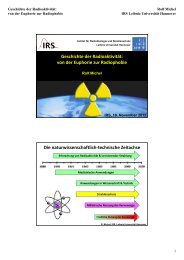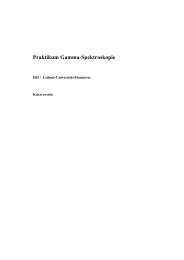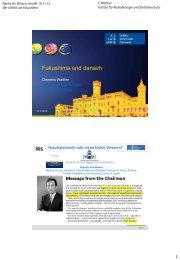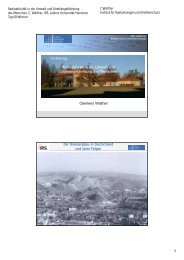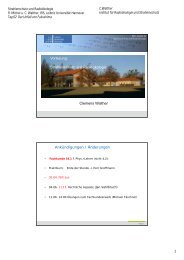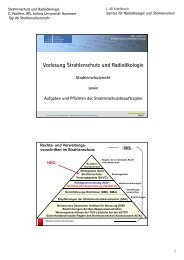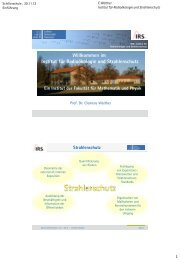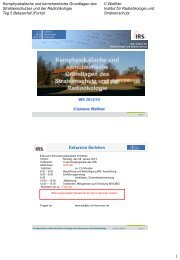Erfolgreiche ePaper selbst erstellen
Machen Sie aus Ihren PDF Publikationen ein blätterbares Flipbook mit unserer einzigartigen Google optimierten e-Paper Software.
264 GLOSSAR<br />
wavelength (’red end’) and shortest wavelength (’blue end’). The light might either form a continuous<br />
spectra or consist of several lines enveloped under an amplitude function with a finite<br />
spectral width. In the case of a laser this might be the spectral function of the medium which<br />
envelopes different resonator modes which are simultaneously present. (Eq. (2.67)) [p. 36]<br />
Stabiler Resonator Stable Resonator. Laser resonator which refocuses the beam priodically by means<br />
of concave mirrors and exhibits relatively low diffraction losses. (Eq. (2.59)) [p. 32]<br />
Stern-Volmer Gleichung The Stern-Volmer equation describes the decrease of the fluorescence intensity<br />
as a function of the concentration of quenchers (Eq. (4.24)) [p. 103]<br />
Stimulierte Emission → Induzierte Emission (Eq. (2.0)) [p. 14]<br />
Strahlungsdruck Radiation pressure. A photon of energy hν carries a momentum p = hν/c =<br />
hk/(2π). When this photon is absorbed, the momentum is transfered to the absorber, which<br />
can be directly measured in the case of an absorbing atom and plays an important role during<br />
laser cooling. A light wave which consists of a large number of photons transfers their<br />
total momentum towards a macroscopic absober and this momentum transfer is denominated<br />
’Radiation pressure’. (Eq. (3.1)) [p. 43]<br />
Superradianz superradiance. When a pupulation-inverted ensemble deexcites by spontaneuos emssion<br />
(fluorescence) instead of stimulated emission, the resulting light is neither coherent, nor<br />
monochromatic. Superradiance occurs when the lasing threshold is exceeded to far (depending<br />
on lifetime of the excited state) or when the seeding, i.e. the weak radiation that initiates<br />
stimulated emission, is not properly aligned. (Eq. (2.30)) [p. 21]<br />
Thomas-Reiche-Kuhn Regel also f-sum rule. If we consider the optical absorption spectrum of<br />
a molecule, the integral of absorption cross-section over photon energy must not exceed<br />
1.098 eV˚A 2 /electron. More precisely: One electron of a molecule accounts for a certain<br />
maximum osillator strength of electric dipole transitions. From the moments of first order<br />
in a randomn phase approximation calculation follows � σ(E)dE = 2π 2 q2 �c<br />
4πɛ0·mc 2 Z =<br />
1.098 eV˚A 2 Z. (Eq. (4.18)) [p. 96]<br />
Threshold → breakdown threshold (Eq. (7.14)) [p. 202]<br />
Vier Niveau Laser Four level laser. Lasertype where the lasing medium is excited to a high lying<br />
state from which the upper lasing level is populated. Lasing action takes place to a third level<br />
which decays towards an even lower state (or the ground state). The latter depopulation<br />
process decreases reabsorption losses. (Eq. (3.23)) [p. 54]<br />
Wirkungsquerschnitt (Reaction) Cross-section. This quantity, typically denominated σ or µn is used<br />
for describing the propability of a reaction and has the unit length 2 , e.g. cm 2 . The product<br />
of the cross-section and the flux density of reactants is the reaction rate: (Cross-section)<br />
x (number of photons/unit area per second) = rate of absorptions. For atomic photon absorption<br />
off resonance typical cross sections are 10 −20 − 10 16 cm 2 . Older unit: 10 16 cm 2 =<br />
1˚A 2 (Eq. (3.3)) [p. 44]<br />
Young-Experiment T. Young, 1801. In this experiment, Young identified the phenomenon called<br />
interference. Observing that when light from a single source is split into two beams, and the<br />
two beams are then recombined, the combined beam shows a pattern of light and dark fringes,



